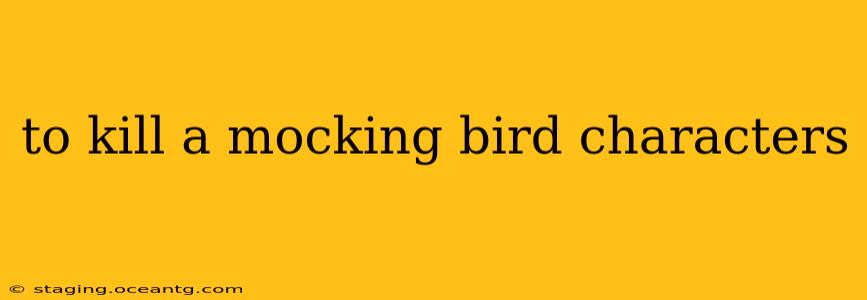To Kill a Mockingbird: Exploring the Novel's Unforgettable Characters
Harper Lee's To Kill a Mockingbird isn't just a coming-of-age story; it's a profound exploration of racial injustice and childhood innocence, all woven through a tapestry of richly developed characters. Each individual, from the central protagonists to the seemingly minor players, contributes to the novel's enduring power and leaves a lasting impression on the reader. This deep dive will explore the key characters and their significance to the narrative.
Scout Finch (Jean Louise Finch):
Scout, the narrator, is a precocious and observant young girl who chronicles her experiences growing up in the racially charged South. Her journey is one of learning, both about the complexities of the adult world and the prejudices that permeate her society. Scout's perspective, innocent yet insightful, allows readers to experience the events of the story with a childlike wonder, while simultaneously highlighting the harsh realities of racism and inequality. Her evolution throughout the novel, from a somewhat naive child to a more understanding young girl, is central to the themes of growth and empathy.
Atticus Finch:
Atticus, Scout's father, stands as a moral compass in the novel. He is a lawyer who defends Tom Robinson, a black man falsely accused of rape, despite facing significant social pressure and hostility from the community. Atticus embodies integrity, courage, and unwavering belief in justice. He teaches Scout and Jem valuable lessons about empathy, understanding, and the importance of standing up for what is right, even when it's difficult. His actions and words shape the children's understanding of morality and the complexities of the human condition.
Jem Finch:
Jem, Scout's older brother, acts as a bridge between Scout's childhood innocence and the harsh realities of the adult world. He undergoes a significant transformation throughout the novel, moving from a playful and somewhat naive child to a more thoughtful and mature young boy. His experiences with Boo Radley and the Tom Robinson trial profoundly impact his worldview, forcing him to confront the prejudices and injustices of his society.
Boo Radley (Arthur Radley):
Boo Radley, a mysterious recluse, represents the misunderstood and marginalized. He's a symbol of fear and mystery within the community, but ultimately reveals himself to be kind and protective. His actions, though initially hidden, demonstrate his inherent goodness and compassion. The contrast between the community's perception of Boo and his true nature highlights the dangers of prejudice and the importance of looking beyond surface appearances.
Tom Robinson:
Tom Robinson is the victim of a miscarriage of justice, wrongly accused of raping Mayella Ewell. His character serves as a poignant representation of the systematic racism and injustice faced by African Americans in the South. Tom's tragic fate underscores the novel's central theme of racial inequality and the devastating consequences of prejudice.
Mayella Ewell:
Mayella Ewell, the accuser of Tom Robinson, is a complex character who embodies both victimhood and perpetuation of injustice. Her life of poverty and neglect has shaped her actions, and her false accusation stems from a desperate attempt to gain attention and escape her difficult circumstances. Her character demonstrates the devastating effects of poverty and societal inequalities.
Bob Ewell:
Bob Ewell, Mayella's father, is a despicable character who represents the epitome of hatred and prejudice. His actions, motivated by racism and a sense of entitlement, drive the central conflict of the novel. His character serves as a stark reminder of the destructive power of prejudice and the importance of fighting for justice.
What other important characters are in To Kill a Mockingbird?
Many other characters contribute to the rich tapestry of the novel, including Miss Maudie Atkinson (a kind neighbor who offers wisdom and support), Calpurnia (the Finch family's housekeeper who provides a crucial bridge between the white and black communities), and Dill Harris (Scout and Jem's summer friend who fuels their imagination and fascination with Boo Radley). Each character plays a vital role in shaping the narrative and exploring the novel's central themes.
This exploration delves into the key characters of To Kill a Mockingbird, highlighting their individual significance and their collective contribution to the novel's enduring impact. Understanding these characters is crucial to fully grasping the novel's complex themes and enduring message.
